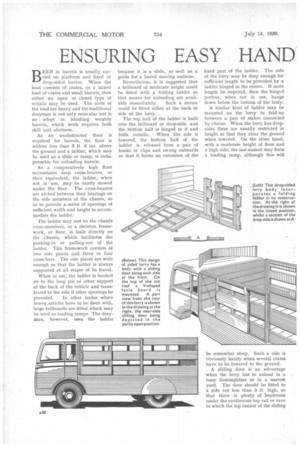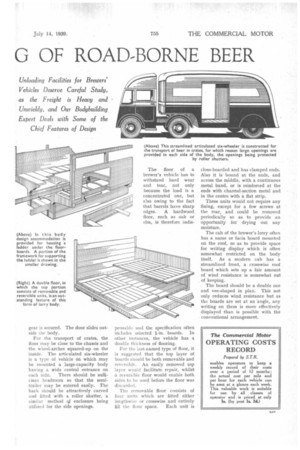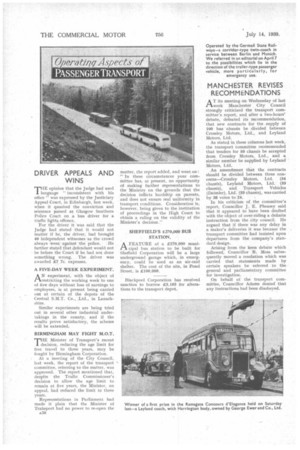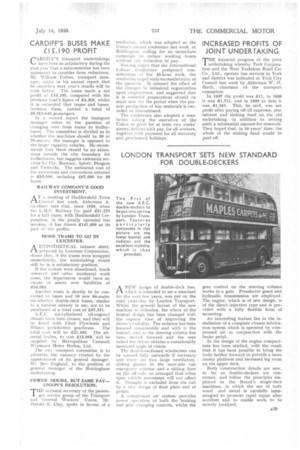ENSURING EASY HAND G OF ROAD-BORNE BEER
Page 46

Page 47

Page 48

Page 49

If you've noticed an error in this article please click here to report it so we can fix it.
Unloading Facilities for Brewers' Vehicles Deserve Careful Study, as the Freight is Heavy and Unwieldy, and Our Bodybuilding Expert Deals with Some of the
Chief Features of Design
BEER in barrels is usually carried on platform and fixed or drop-sided lorries. When the load consists of crates, or a mixed load of crates and small barrels, then either an open or closed type of vehicle may be used. The units of the load are heavy and the traditional drayman is not only muscular but is an adept in handling weighty barrels, which work requires both skill and alertness.
As an unobstructed floor is required for barrels, the floor is seldom less than 3 ft. 6 ins, above the-ground and a ladder, which may be used as a slide or ramp, is indispensable for unloading barrels.
As a comparatively high floor necessitates deep cross-bearers, or their equivalent, the ladder, when not in use, may be neatly stowed under the floor. The cross-bearers are arched between their bearings on the side members of the chassis, so as to provide a series of openings of sufficient width and height to accommodate the ladder.
The ladder may rest on the chassis cross-members, or a skeleton framework, or floor, is built directly on the chassis, which facilitates the pushing-in or pulling-out of the ladder. This framework consists of two side pieces and three or four cross-bars. The side pieces are wide enough so that the ladder is always supported at all stages of its travel.
When in use, the ladder is booked on to the long pin or other support at the-back of the vehicle and transferred to the side if other openings be provided. In other trades where heavy articles have to be dealt with, large tailboards are fitted which may be used as loading ramps. The drayman, however, uses the ladder because it is a slide, as well as a guide for a barrel moving endwise.
Nevertheless, it is suggested that a tailboard of moderate height could be fitted with a folding ladder so that means for unloading are avail able immediately. Such a device could be fitted either at the back or side of the lorry.
The top half of the ladder is built into the tailboard or drop-side, and the bottom half is hinged to it and folds outside. When the side is lowered, the bottom half of the ladder is released from a pair of hooks or clips and swung outwards so that it forms an extension of the fixed part of the ladder. The side of the lorry may be deep enough for sufficient length to be provided by a ladder hinged in the centre. If more length be required, then the hinged portion, when not in use, hangs down below the bottom of the body.
A similar kind of ladder may be mounted on the lorry to fold-up between a pair of stakes connected by chains. When the lorry has dropsides these are usually restricted in height so that they clear the ground when lowered. On the other hand, with a moderate height of floor and a high side, the last-named may form a loading ramp, although this will be somewhat steep. Such a side is obviously handy when several crates have to be lowered to the ground.
A sliding door is an advantage when the lorry has to unload in a busy thoroughfare or in a narrow yard. The door should be fitted to a side not less than 3 ft. high, so that there is plenty of headroom under the continuous top rail or rave to which the top runner of the sliding gear is secured. The door slides outside the body.
For the transport of crates, the floor may be close to the chassis and the wheel-arches squared-up on the inside. The articulated six-wheeler is a type of vehicle on which may be mounted a large-capacity body having a wide central entrance on each side. There should be sufficient headroom so that the semitrailer may be entered easily. The back should be attractively curved and fitted with a roller shutter, a similar method of enclosure being utilized for the side openings. The floor of a brewer's vehicle has to withstand hard wear and tear, not only because the load is a concentrated one, but also owing to the fact that barrels have sharp edges. A hardwood floor, such as oak or elm, is therefore indis pensable and the specification often includes selected 1-in. boards. In other instances, the vehicle has a double thickness of flooring.
For the last-named type of floor, it is suggested that the top layer of boards should be both removable and reversible. An easily removed top layer would facilitate repair, whilst a reversible floor. would enable both sides to be used before the floor was discarded.
The removable floor consists of four units which are fitted either lengthwise or crosswise and entirely fill the floor space. Each unit is
close-boarded and has clamped ends. Also it is bound at the ends, and across the middle, with a continuous metal band, or is reinforced at the ends with channel-section metal and in the centre with a flat strip.
These units would not require any fixing, except for a few screws at the rear, and could be removed periodically so as to provide an opportunity for drying out any moisture.
The cab of the brewer's lorry often has a name or facia board mounted on the roof, so as to provide space for writing display which is often somewhat restricted on the body itself. As a modern cab has a streamlined front, a crosswise roof board which sets up a fair amount of wind resistance is somewhat out of keeping.
The board should be a double one and vee-shaped in plan. This not only reduces wind resistance but as the boards are set at an 'angle, any writing on them is more effectively displayed than is possible with the conventional arrangement.
DRIVER APPEALS AND WINS
THE opinion that the Judge had used language " inconsistent with his office " was expressed by the Justiciary Appeal Court, in Edinburgh, last week, when it quashed the conviction and sentence passed at Glasgow Southern Police Court on a bus driver for a traffic lights offence.
For the driver it was said that the Judge had stated that it would not matter if he, the driver, had brought 40 independent witnesses as the crowd always went against the police. He further stated that defendant would not be before the Court if he had not done something wrong. The driver was awarded £7 7s. expenses.
A FIVE-DAY WEEK EXPERIMENT:
AN experiment, with the object of restricting the working week to one of five days without loss of earnings to employees, is at present being carried out at certain of the depots of the Central S.M.T. Co., ,Ltd., in Lanarkshire.
Similar experiments are being tried out in several other industrial undertakings in the county, and if the results prove satisfactory, the scheme will be extended.
BIRMINGHAM MAY FIGHT M.O.T.
THE Minister of Transport's recent decision, reducing the age limit for free travel to three years, may be fought by Birmingham Corporation.
At a meeting of the City Council, last week, the report of the transport committee, referring to the matter, was approved. The report mentioned that, despite the Traffic Commissioner's decision to allow the age limit to remain at five years, the Minister, on appeal, had reduced the limit to three years.
Representations in Parliament had made it plain that the Minister of Trahsport had no power to re-open the matter, the report added, and went on : " In these circumstances your committee has, at present, no opportunity of making further representations to the Ministry on the grounds that the decision infficts hardship on parents, and does not ensure real uniformity in transport conditions. Consideration is, however, being given to the institution of proceedings in the High Court to obtain a ruling on the validity of the Minister's decision."
SHEFFIELD'S 1270,000 BUS STATION.
A FEATURE of a £270,000 muni
cipal bus station to be built for Sheffield Corporation will be a large underground garage which, in emergency, could be used as an air-raid shelter. The cost of the site, in Pond Street, is £100,000.
Blackpool Corporation has received sanction to borrow £3,163 for alterations to the transport depot.
MANCHESTER REVISES RECOMM ENDATIONS
A Tits meeting on Wednesday of last
week Manchester City Council strongly criticized the transport committee's report, and after a two-hours' debate, defeated its recommendation, that new contracts for the supply of 100 bus chassis be divided between Crossley Motors, Ltd., and Leyland Motors, Ltd.
As stated in these columns last week, the transport committee recommended that tenders for 50 chassis be accepted from Crossley Motors, Ltd., and a similar number be supplied by Leyland Motors, Ltd.
An amendment that the contracts should be divided between three concerns—Crossley Motors, Ltd. (34 chassis), Leyland Motors, Ltd. (33 chassis), and Transport Vehicles (Daimler), Ltd. (33 chassis), was carried by 38 votes to 24.
In his criticism of the committee's report, Councillor J. E. Phea.sey said that it appeared to have been drafted with the object of over-riding a definite instruction from the city council. He argued that if there was any delay in a maker's deliveries it was because the transport committee had insisted upon departures from the company's standard design.
Arising from the keen debate which followed, Councillor R. Moss subsequently moved a resolution which was carried that statements made by certain speakers be referred to the general and parliamentary committee for investigation.
On behalf of the transport committee, Councillor Adams denied. that any instructions had been disobeyed.
CARDIFF'S BUSES MAKE 15,190 PROFIT
rARDII-F'S transport undertakings.
have been so satisfactory during the past year that a subcommittee has been appointed to consider fares reductions. Mr. William Forbes, transport manager, states in his annual report that he considers next year's results will be even better, The buses made a net profit. of £15,190, compared with the previous year's figure of £4,306, whilst it is estimated that trains and buses, between them, carried a total of 58.313,640 passengers.
In a second report the transport manager refers to the question of changing over from trams to trolleybuses. The committee is divided as to whether the machines should be 56 or 70-seaters: the manager is opposed to the larger rapacity vehicles. He recommends that there should be -no extensions outside the city boundary for trolleybuses, but suggests extension services for Ely, Rummy, Splott, Pengam and Tremorfa, The estimated cost of the extensions and conversions entailed is £95,000, including 267,500 for 30 buses.
RAILWAY COMPANY'S GOOD INVESTMENT.
AT a meeting of Fluddersfield Town Council last week, Alderman A. Gardiner said that, since 1929, when the L.M.S. Railway Co. paid £51,270 for a half share, with Huddersfield Corporation, in the jointly operated bus services, it has drawn £141,400 as its part of the profits.
MORE TRAMS TO GO IN LEICESTER.
AHYPOTHETICAL balance sheet, prepared by Leicester Corporation, shows that, if the trams were scrapped immediately, the undertaking would still be in a satisfactory position.
If the system were abandoned, track removed and other incidental work done, the department would have an excess of assets over liabilities of £34,083.
Another route is shortly to be converted to buses and 16 new 64-seater six-wheeled double-deck buses, similar to a number already in use, are to be purchased at a total cost of 237,371.
A.E.C. six-cylindered oil-engined chassis have been chosen, and they will be fitted with Fluid Flywheels and Wilson preselective gearboxes. Thetotal cost will be £21,402. The allmetal bodies, to cost 215,968, will be supplied by Metropolitan Cammell Weyniann Motor Bodies, Ltd.
The city transport committee is to advertise the vacancy created by the appointment of its general manager, Mr. Ben England, to the -position of general manager of the Nottingham undertaking.
FEWER HOURS, BUT SAME PAY— UNION'S RESOLUTION.
rr'HE national secretary of the passenger service group of the Transport and General Workers' Union, Mr. Harold E.. Clay, spoke in favour of a
resolution. which was adopted at the Union's annual conference last week, at Bridlington, calling for an immediate campaign to reduce working hours without any reduction in pay.
Voicing regret that the International Labour Conference postponed consideratiou of the 40-hour week, the resolution urged early reconsideration of the question. It stressed the effect of the changes in industrial organization upon employment, and suggested that it is essential preparations should he made now for the period when the preseat production of warmaterials is curtailed or discontinued, The conference also adopted a resolution asking the exeeutive of the Union to press for at least two weeks' annual holiday with pay, for all workers, together with payment for all statutory and proclaimed holidays.
INCREASED PROFITS OF JOINT UNDERTAKING
THE financial progress of the joint undertaking whereby York Corporation and the West Yorkshire Road Car Co., Ltd., operate bus services in York and district was indicated at York City Council last week by Alderman W. H. Birch, chairman of the transport committee.
In 1937 the profit was £11, in 1938 it was £1,711, and in 1939 to date it was £1,341. This, he said, was net profit after paying off all expenses, plus interest and sinking fund on the old undertaking, in addition to setting aside a substantial amount for renewals. They hoped that, in 10 years' time, the whole of the sinking fund would be paid off.












































































